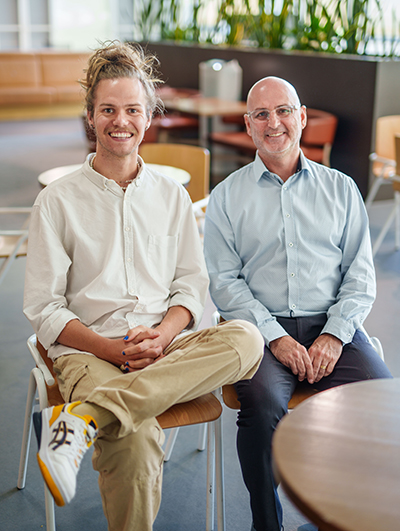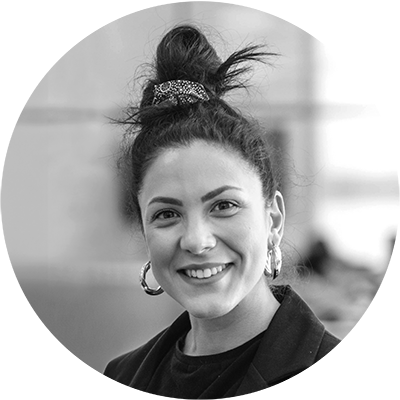16 July 2024
AUTHOR: Annabel Mansfield
VIDEOGRAPHER: Robbie Fatt
Step into any early childhood education centre, and you'll encounter a whirlwind of activity: colourful art, energetic play and caring educators shaping young minds. But amid the vibrancy, there's something often missing … male educators.
The lack of male carers and educators is a longstanding issue, both locally and around the world. Yet in Australia, it’s early childhood education that’s most affected, with fewer than 3% of men in this workforce.
It’s a dismal statistic, and despite increasing awareness of the importance of both men and women taking on and being seen in caring roles, most early learning centres and preschools do not have a male educator or teacher.

UniSA education expert Dr Martyn Mills-Bayne says that fighting for gender diversity in Early Childhood Education and Care (ECEC) is vital for children’s development.
“The first five years of a child’s life are critical for their development,” Dr Mills-Bayne says. “This is when a child learns about their emotions, how they think, and how they communicate and connect with others.
“A core part of this is ensuring that young children are cared for by healthy and positive role models – which includes both men and women.
“But with men vastly underrepresented in childcare and early education settings, young children are missing out.
“Young children benefit enormously from male teachers and carers in early childhood settings, and when young children are cared for by both men and women, we’re showing children that all genders matter, and that ‘caring’ and ‘being kind’ are valued across genders.”
Breaking down outdated stereotypes is key to a well-functioning society in which all people – regardless of gender – have equal opportunities to thrive and succeed. However, reports show there is still a long way to go to achieving this.
Some professions becoming even more female-dominated
Gender segregation is entrenched across many critical professions in Australia, with caring roles typically occupied by women, and labour-intensive roles held by men. But while there’s a general belief that gender diversity is improving, statistics show the opposite is happening in some fields. Over the past 30 years, childcare workers and primary school teachers have become even more female-dominated and are now in the top five most gender segregated careers.
So, what can be done? The starting point, perhaps, is advocacy.

Earlier this year, a group of prominent early childhood experts, including Dr Mills-Bayne, launched a national strategy – the Thrive by Five Dad’s Alliance Action Plan – to help fathers play a more active role in their children’s lives. The initiative aims for men to be more present and active in their children’s lives in their first five years, as well as for more male carers and educators to be in early learning and childcare professions.
Director of Thrive by Five Jay Weatherill AO, says the Dad’s Action Plan intends to bring about huge change to young children’s lives by addressing outdated stereotypes.
“Every child should have the right to thrive by five,” Weatherill says. “An essential part of that is to ensure we have a high-quality childcare, early learning and education system.
“Involving men in early childhood education settings is very important for both young boys and young girls to see that a nurturing role can be undertaken by a male.
“That’s going to be important not only for their experiences and relationships that they form in life, but also a more inclusive society.”
Inclusivity and increased diversity among early childhood educators lets children interact with a wider range of adults who better reflect society.
Boys need to see that caring is not the role of any particular gender
Dr Mills-Bayne says when children see adults who look like them, it encourages them to feel good about who they are, and where they fit into the world.
“You can’t be what you can’t see,” Dr Mills-Bayne says.
“When young boys don’t see men in early education or carer roles, that is until upper primary or even high school, they inherently learn that men do not belong in such roles, which only adds to a cycle of gender segregation.
“Gender diversity is important for young children – particularly young boys. When early childhood education embraces a gender diverse workforce, young children experience rich and nurturing relationships with different genders, as well as the day-to-day interactions between men, women, and non-binary educators that they might otherwise miss out on.
“Young children deserve access to a diverse early childhood education and care workforce where they can see their identities reflected daily.
“When it comes down to it, quality teaching is quality teaching – we need both male and female teachers and carers – but with men represented so poorly across early childhood education and care, something must change.”
 Reception teacher Luke Springer with Dr Martyn Mills-Bayne.
Reception teacher Luke Springer with Dr Martyn Mills-Bayne.Reception teacher ‘Mr Luke’ tackles stereotypes
One individual who is challenging the status quo is South Australian Reception teacher and UniSA graduate, Luke Springer. Known for his infectious energy and enthusiasm, both in the classroom and on his popular social media platforms, 'Mr Luke' is breaking barriers on many levels.
“Teaching is so enjoyable – I wake up every day and love what I do,” Springer says. “I love that every day is different and that I get to make a positive impact on these tiny humans, my little legends.
“I have a lot of fun teaching little ones. I consider my little people real sponges – they just consume everything around them. They have such interest in everything we put forward and a real desire to learn to navigate the world.
“But at the same time, I want to be able to show my students that males can be caring and that males can be in that positive nurturing role.
“It’s really important for my students to see males like me show emotion, or have long hair, or paint my nails – simply because I like to. And it’s empowering for a child to make that connection and go, ‘Oh, it’s ok if I have long hair, because Luke has long hair’; I didn’t realise representation was this powerful.”
 The 'other realm' that Mr Luke occupies is social media where he presents a fun snapshot into the life of a teacher.
The 'other realm' that Mr Luke occupies is social media where he presents a fun snapshot into the life of a teacher.While ‘Mr Luke’ successfully asserts his individuality in the classroom, the power to employ male teachers resides in leadership – both within the early childhood and education sector, and across government.
In May, Australian Prime Minister Anthony Albanese acknowledged the incredible value of education to Australia.
“Education is the single most powerful weapon we have against disadvantage,” he said in a Public Education Day address. “And it’s the single best investment we can make in our nation’s future.”
Now, with the South Australian 2024-25 Budget investing $715 million over five years to implement universal 3-year-old preschool and other key recommendations from the Royal Commission into Early Childhood Education and Care, there is scope to target under underrepresented groups in the early childhood education and care workforce.

UniSA early childhood teacher, graduate and executive director of early education and care service Yawarra Children's Services, Diamond Sinanis, is an avid supporter of male carers and teachers.
“For me, it was really important to employ males, as I wanted the children in my centres to look up to both men and women,” Sinanis says.
“Children tend to idolise the people that they’re surrounded by. We all mix with males and females, so why shouldn’t young children experience the same in day care?
“The male educators and teachers that I have at both of my sites are fantastic. Each of them has built absolutely incredible relationships with the children and their families, and they add a great energy and sense of fun.”
While support for male teachers in early childhood education and care is clear, the struggle to recruit them to the sector persists. This is exacerbated by a national teacher shortage.
Dr Mills-Bayne says that by increasing the gender diversity of the early childhood education and care workforce, “we can create inclusive learning environments that cater to the diverse needs of all children and provide clear examples of positive male involvement in children’s lives”.
“But attracting and retaining men to the sector requires proactive intervention and targeted investment, both nationally and around the world,” he says.
Action needed to attract men to early childhood education and care
“The lack of male early childhood educators is a global issue. Right now, we’re collaborating with international partners to build a shared vision of a more gender diverse early childhood education and care workforce, but rather than just talking about the issues, we need to start acting on them.”
To make sustainable change, the sector requires targeted funding.
“We need more resources to promote the benefits of males in early childhood education and care so that we can encourage men to pursue careers in this field,” Dr Mills-Bayne says.
“And instead of enveloping men in overarching initiatives that address teaching as a whole, we need messages that are explicitly targeted at men.
“Developing male-focused campaigns that show the early childhood education and care profession to be rewarding, fun, and above all, a valid and valuable profession for men, is vital if we are to instigate real change.
“Investment is key. We must establish scholarships and grants that target men who may be interested in pursuing Initial Teacher Education degrees, or VET certifications in early childhood education, to help reduce financial barriers and increase accessibility.
“We also need to invest in professional development programs to provide ongoing support and mentorship for male educators already teaching in the sector, enabling them to thrive in their current teaching roles.
“And we need to allocate research funding to better understand the factors influencing male participation in early childhood education and care and identify effective strategies for increasing representation.
“It’s not a small ask, but it is a necessary one if we wish to make lasting and positive change.
“If we can achieve even 5-10% of the early childhood education and care workforce being men – that’d be a huge achievement for gender diversity, not only enriching the sector, but delivering a brighter future for our children.”
You can republish this article for free, online or in print, under a Creative Commons licence, provided you follow our guidelines.


